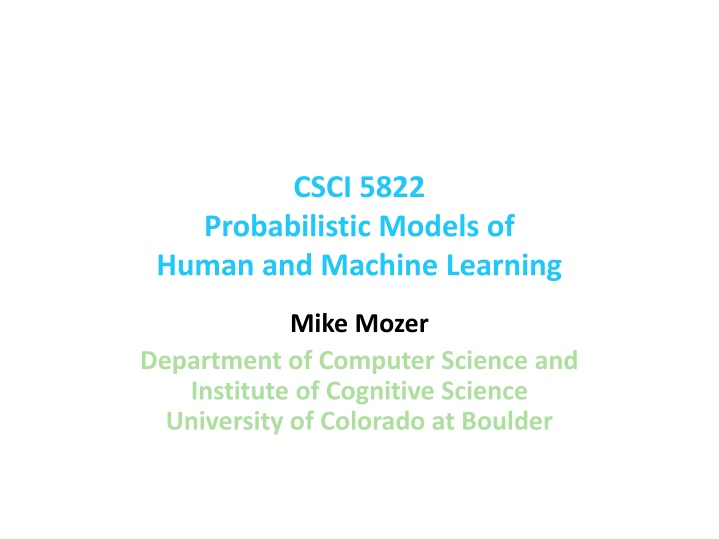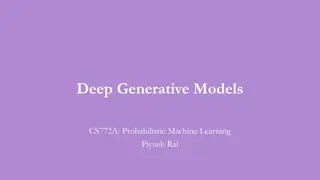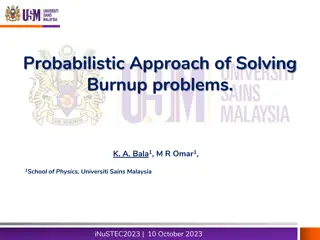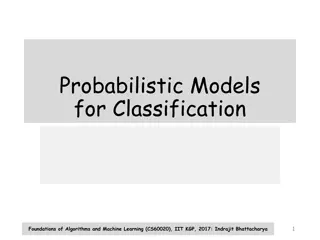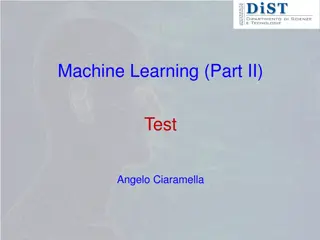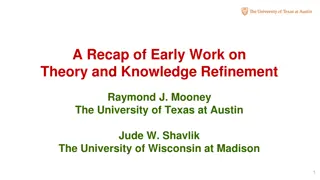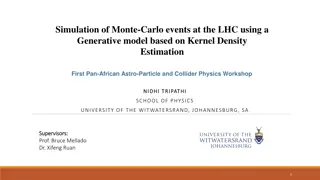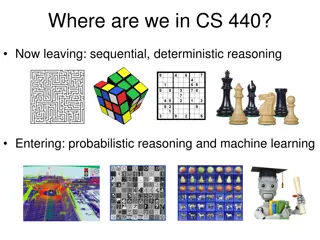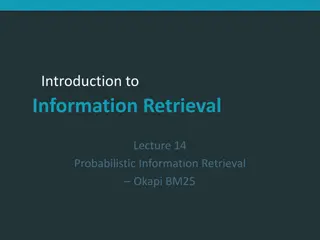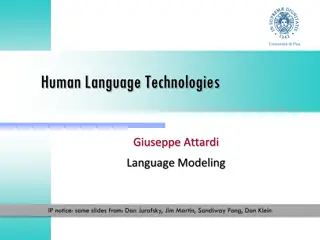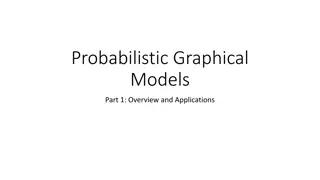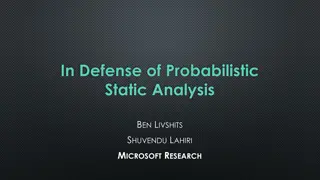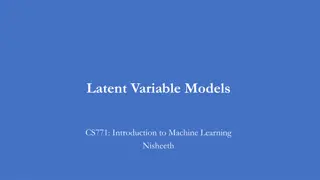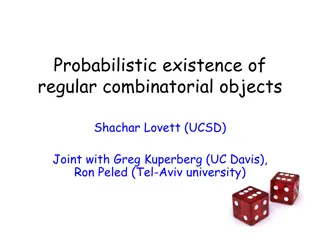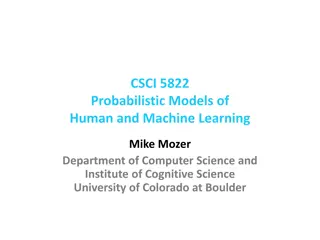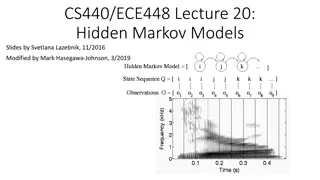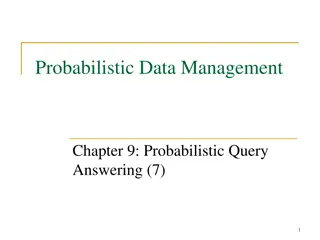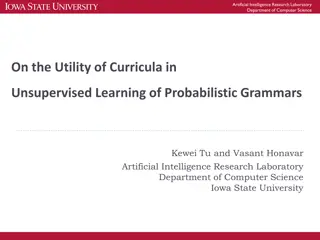CSCI 5822 Probabilistic Models of Human and Machine Learning
In this resource, Mike Mozer from the University of Colorado at Boulder delves into Probabilistic Models of Human and Machine Learning, focusing on Bayesian Networks, General Learning Problems, Classes of Graphical Model Learning Problems, and more. The content covers learning distributions when network structure is known, recasting learning as Bayesian inference, and learning conditional probability distributions. The discussions touch on inferring unknown parameters, Bayesian methods for parameter estimation, and the relationship between learning and Bayesian inference.
Uploaded on Mar 08, 2025 | 1 Views
Download Presentation

Please find below an Image/Link to download the presentation.
The content on the website is provided AS IS for your information and personal use only. It may not be sold, licensed, or shared on other websites without obtaining consent from the author.If you encounter any issues during the download, it is possible that the publisher has removed the file from their server.
You are allowed to download the files provided on this website for personal or commercial use, subject to the condition that they are used lawfully. All files are the property of their respective owners.
The content on the website is provided AS IS for your information and personal use only. It may not be sold, licensed, or shared on other websites without obtaining consent from the author.
E N D
Presentation Transcript
CSCI 5822 Probabilistic Models of Human and Machine Learning Mike Mozer Department of Computer Science and Institute of Cognitive Science University of Colorado at Boulder
General Learning Problem Set of random variables X = {X1, X2, X3, X4, } Training set D = {X(1), X(2), , X(N)} Each observation specifies values of subset of variables X(1)= {x1, x2, ?, x4, } X(2)= {x1, x2, x3, x4, } X(3)= {?, x2, x3, x4, } Goal Estimate conditional joint distributions E.g., P(X1, X3| X2, X4)
Classes Of Graphical Model Learning Problems Network structure known All variables observed next few classes Network structure known Some missing data (or latent variables) Network structure not known All variables observed going to skip (not too relevant for papers we ll read; see optional readings for more info) Network structure not known Some missing data (or latent variables)
If Network Structure Is Known, The Problem Involves Learning Distributions The distributions are characterized by parameters ? ?. Goal: infer ? ? that best explains the data D. p(q D)~ p(Dq)p(q) Bayesian methods q*= argmaxqp(q D) Maximum a posteriori q*= argmaxqp(Dq) Maximum likelihood e i (e)x\i (e),q) q*= argmaxq log p(xi Max. pseudo-likelihood 1 e Moment matching x(e) )2 q*= argminq(Ep(xq)[x]- | X |
Learning CPDs When All Variables Are Observed And Network Structure Is Known Maximum likelihood estimation is trivial X Y P(X) P(X) P(Y) ? ? ? Training Data Z X Y Z 0 0 1 X Y P(Z|X,Y) 0 1 1 0 0 ? 0 1 0 0 1 ? 1 1 1 1 0 ? 1 1 1 1 1 ? 1 0 0
Recasting Learning As Bayesian Inference We ve already used Bayesian inference in probabilistic models to compute posteriors on latent (a.k.a. hidden, nonobservable) variables from data. E.g., Weiss model Direction of motion E.g., Gaussian mixture model To which cluster does each data point belong Why not treat unknown parameters in the same way? E.g., Gaussian mixture parameters E.g., entries in conditional prob. tables
Recasting Learning As Inference Suppose you have a coin with an unknown bias, P(head). You flip the coin multiple times and observe the outcome. From observations, you can infer the bias of the coin This is learning. This is inference.
Treating Conditional Probabilities As Latent Variables Graphical model probabilities (priors, conditional distributions) can also be cast as random variables E.g., Gaussian mixture model ? z z z x x x Remove the knowledge built into the links (conditional distributions) and into the nodes (prior distributions). Create new random variables to represent the knowledge Hierarchical Bayesian Inference
Im going to flip a coin, with unknown bias. Depending on whether it comes up heads or tails, I will flip one of two other coins, each with an unknown bias. X: outcome of first flip Y: outcome of second flip Slides stolen from David Heckerman tutorial
training example 1 training example 2
Parameters might not be independent training example 1 training example 2
General Approach: Bayesian Learning of Probabilities in a Bayes Net If network structure Sh known and no missing data We can express joint distribution over variables X in terms of model parameter vector s Given random sample D = {X(1), X(2), , X(N)}, compute the posterior distribution p( s | D, Sh) Probabilistic formulation of all supervised and unsupervised learning problems.
Computing Parameter Posteriors E.g., net structure X Y
Computing Parameter Posteriors Given complete data (all X,Y observed) and no direct dependencies among parameters, parameter independence Explanation Given complete data, each set of parameters is disconnected from each other set of parameters in the graph X x x x Y y|x D separation
Posterior Predictive Distribution p(qs| D,Sh) Given parameter posteriors What is prediction of next observation X(N+1)? qs p(X(N+1)| D,Sh)= p(X(N+1)|qs,D,Sh) p(qs| D,Sh)dqs What we talked about the past three classes What we just discussed How can this be used for unsupervised and supervised learning? What does this formula look like if we re doing approximate inference by sampling s?
Prediction Directly From Data In many cases, prediction can be made without explicitly computing posteriors over parameters E.g., coin toss example from earlier class p(q)= Beta(q |a,b) Posterior distribution is p(q | D)= Beta(q |a +nh,b +nt) Prediction of next coin outcome P(xN+1| D)= P(xN+1|q) q p(q | D)dq a +nh = a +b +nh+nt
Terminology Digression Bernoulli : Binomial :: Categorical : Multinomial single coin flip N flips of coin (e.g., exam score) single roll of die N rolls of die (e.g., # of each major)
Generalizing To Categorical RVs In Bayes Net notation change Variable Xi is discrete, with values xi1, ... xiri i: index of categorical RV j: index over configurations of the parents of node i k: index over values of node i Xa Xb Xi unrestricted distribution: one parameter per probability
Prediction Directly From Data: Categorical Random Variables Prior distribution is Posterior distribution is Posterior predictive distribution: I: index over nodes j: index over values of parents of I k: index over values of node i
Other Easy Cases Members of the exponential family see Barber text 8.5 Linear regression with Gaussian noise see Barber text 18.1
